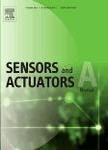版权所有:内蒙古大学图书馆 技术提供:维普资讯• 智图
内蒙古自治区呼和浩特市赛罕区大学西街235号 邮编: 010021

作者机构:Natl Cheng Kung Univ Dept Mech Engn 1 Dasyue Rd Tainan 701 Taiwan
出 版 物:《SENSORS AND ACTUATORS A-PHYSICAL》 (传感器与执行机构,A辑:物理传感器)
年 卷 期:2019年第285卷
页 面:468-481页
核心收录:
学科分类:12[管理学] 1201[管理学-管理科学与工程(可授管理学、工学学位)] 0808[工学-电气工程] 08[工学] 0804[工学-仪器科学与技术]
基 金:ministry of science and technology (MOST) of Taiwan [MOST 104-2221-E-006-121, 107-2622-8-006-015, 107-2218-E-006-002] "Intelligent Manufacturing Research Center" (iMRC) from The Featured Areas Research Center Program
主 题:Localization Load-cell Smart floor Touch panel Force sensing
摘 要:Accurate position detection of indoor objects is crucial for many intelligent life applications and can be realized by various approaches. In certain applications, indoor position detection can be performed using some forms of touch-based floor sensing systems to avoid problems faced by using vision or inertial navigation approaches. The present study develops a floor panel test stage (1 x 1 m(2)) and its associated localization schemes based on rigid body statics for evaluating the feasibility and the positioning performance on determining the indoor locations of moving objects such as mobile robots. The motion signals are detected by four load cells located at the panel corners and are used to determine the position of the applied forces by means of rigid body statics. Essential tests are performed to examine the system performance. Noticed that due to the existence of boundary reaction moments, traditional predictions based on rigid body statics may not be sufficient and a calibration procedure is required. In parallel, for accommodating different possible scenarios, the corresponding associated localization schemes for estimating the force-applied locations based on the readout history and algorithms are also proposed and realized. The results indicate that the localization accuracy is approximately +/- 1 cm over a 1 m span after calibration. Although the method is essentially static, it can still detect object motion provided the motion frequency less than 2 Hz. Furthermore, demonstrations are also presented to highlight other possible applications such as center of gravity measurement of objects and the fusion of multiple localization schemes in indoor environment. Finally, an indoor localization demonstration based on both wiimote IR LED and this smart floor is presented to elucidate the possible application of this work in sensor fusion for indoor motion control. (C) 2018 Elsevier B.V. All rights reserved.